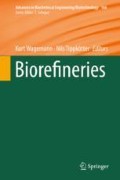Abstract
The term anaerobic digestion usually refers to the microbial conversion of organic material to biogas, which mainly consists of methane and carbon dioxide. The technical application of the naturally-occurring process is used to provide a renewable energy carrier and – as the substrate is often waste material – to reduce the organic matter content of the substrate prior to disposal.
Applications can be found in sewage sludge treatment, the treatment of industrial and municipal solid wastes and wastewaters (including landfill gas utilization), and the conversion of agricultural residues and energy crops.
For biorefinery concepts, the anaerobic digestion (AD) process is, on the one hand, an option to treat organic residues from other production processes. Concomitant effects are the reduction of organic carbon within the treated substance, the conversion of nitrogen and sulfur components, and the production of an energy-rich gas – the biogas. On the other hand, the multistep conversion of complex organic material offers the possibility of interrupting the conversion chain and locking out intermediates for utilization as basic material within the chemical industry.
References
IRENA (2015) http://resourceirena.irena.org/gateway/download. 11.1.2015
Scheftelowitz M et al (2015) Stromerzeugung aus Biomasse Zwischenbericht Mai 2015 DBFZ, download: www.dbfz.de 10.8.2015
FNR (2015) Mediathek. https://mediathek.fnr.de/grafiken/daten-und-fakten/anbau/entwicklung-der-maisanbauflache-in-deutschland.html. download 15.8.2015
Nyns E-J, Nikolausz M, Liebetrau J (2014) Biogas in Ullmann’s encyclopedia of industrial chemistry. Wiley-VCH Verlag GmbH & Co. KGaA, Weinheim. Online ISBN: 9783527306732 doi:10.1002/14356007.a16_453.pub2
Doi RH, Kosugi A (2004) Cellulosomes: plant-cell-wall-degrading enzyme complexes. Nat Rev Microbiol 2:541–551. doi:10.1038/nrmicro925
Miron J, Ben-Ghedalia D, Morrison M (2001) Invited review: adhesion mechanisms of rumen cellulolytic bacteria. J Dairy Sci 84:1294–1309. doi:10.3168/jds.S0022-0302(01)70159-2
Mata-Alvarez J, Macé S, Llabrés P (2000) Anaerobic digestion of organic solid wastes. An overview of research achievements and perspectives. Bioresour Technol 74:3–16. doi:10.1016/S0960-8524(00)00023-7
Spirito CM, Richter H, Rabaey K, et al. (2014) Chain elongation in anaerobic reactor microbiomes to recover resources from waste. Curr Opin Biotechnol 27:115–122. doi:10.1016/j.copbio.2014.01.003
Thauer R, Jungermann K, Decker K (1977) Energy-conservation in chemotrophic anaerobic bacteria. Bacteriol Rev 41:100–180
Wellinger A, Murphy J, Baxter D (eds) (2013) The biogas handbook: science, production and application. Woodhead Publishing. ISBN: 9780857094988
FNR (2013) Leitfaden biogas, 6th edn. Gülzow, FNR
Luo G, Johansson S, Boe K, et al. (2012) Simultaneous hydrogen utilization and in situ biogas upgrading in an anaerobic reactor. Biotechnol Bioeng 109:1088–1094. doi:10.1002/bit.24360
Cheng S, Xing D, Call DF, Logan BE (2009) Direct biological conversion of electrical current into methane by electromethanogenesis. Environ Sci Technol 43:3953–3958. doi:10.1021/es803531g
Burkhardt M, Busch G (2013) Methanation of hydrogen and carbon dioxide. Appl Energy 111:74–79. doi:10.1016/j.apenergy.2013.04.080
Luo G, Angelidaki I (2013) Co-digestion of manure and whey for in situ biogas upgrading by the addition of H-2: process performance and microbial insights. Appl Microbiol Biotechnol 97:1373–1381. doi:10.1007/s00253-012-4547-5
Youngsukkasem S, Chandolias K, Taherzadeh MJ (2015) Rapid bio-methanation of syngas in a reverse membrane bioreactor: membrane encased microorganisms. Bioresour Technol 178:334–340. doi:10.1016/j.biortech.2014.07.071
Wandrey C, Aivasidis A (1983) Zur Reaktionstechnik der anaeroben Fermentation. Chem Ing Tech 55:516–524. doi:10.1002/cite.330550705
Schröder U, Harnisch F, Angenent LT (2015) Microbial electrochemistry and technology: terminology and classification. Energy Environ Sci 8:513–519. doi:10.1039/C4EE03359K
Xu H, Wang K, Holmes DE (2014) Bioelectrochemical removal of carbon dioxide (CO2): an innovative method for biogas upgrading. Bioresour Technol 173:392–398. doi:10.1016/j.biortech.2014.09.127
Author information
Authors and Affiliations
Corresponding author
Editor information
Editors and Affiliations
Rights and permissions
Copyright information
© 2017 Springer International Publishing AG
About this chapter
Cite this chapter
Liebetrau, J., Sträuber, H., Kretzschmar, J., Denysenko, V., Nelles, M. (2017). Anaerobic Digestion. In: Wagemann, K., Tippkötter, N. (eds) Biorefineries. Advances in Biochemical Engineering/Biotechnology, vol 166. Springer, Cham. https://doi.org/10.1007/10_2016_67
Download citation
DOI: https://doi.org/10.1007/10_2016_67
Published:
Publisher Name: Springer, Cham
Print ISBN: 978-3-319-97117-9
Online ISBN: 978-3-319-97119-3
eBook Packages: Chemistry and Materials ScienceChemistry and Material Science (R0)

